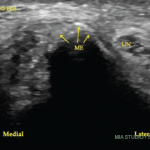According to Dr. Shaver, MSUS allows him to see a greater degree of erosion in the joint than he was previously able to detect with plain radiography. “I found that I was sometimes underestimating the level of degree activity the patient had and underestimating the degree of structural damage that was present when I used more traditional methods of evaluation.”
MSUS can also be useful for diagnosis of gouty arthritis by detecting urate crystals on the surface of cartilage in joints that may be symptomatic or asymptomatic, and also by detecting microtophi, which are invisible on X-rays. This use could significantly change the detection and management of gout in the future, experts contacted for this article predict.
Other reasonable uses of MSUS include:
- To evaluate evidence of enthesopathy for a patient with inflammatory-sounding entheseal, sacroiliac, or spine pain.
- To evaluate underlying structural disorder for a patient with shoulder pain or mechanical symptoms, without definitive diagnosis on clinical exam—but it should not be used for adhesive capsulitis or as preparation for surgical intervention.
- To evaluate for inflammation, tendon, and soft tissue pathologies at the shoulder, elbow, hand, wrist, hip, knee, ankle, and foot.
- To evaluate parotid and submandibular glands in a patient being evaluated for Sjögren’s disease.
- To diagnose entrapment of the median nerve at the carpal tunnel, ulnar nerve at the cubital tunnel, and posterior tibial nerve at the tarsal tunnel in patients with no definitive diagnosis on clinical examination.
- To evaluate effusion, intraarticular, and periarticular lesions, and adjacent regional soft tissues structure in the hip region.
- To facilitate clinical assessment at the glenohumeral, acromioclavicular, elbow, wrist, hand, metacarpophalangeal, interphalangeal, hip, knee, ankle/foot, and metatarsophalangeal joint for patients whose joints are obfuscated by adipose or other local derangements of soft tissue.
- To provide guidance during synovial biopsy procedures.
MSUS procedures that are not considered reasonable due to concerns about risks include evaluation of giant cell arteritis, eoiosinophilic fasciitis, myositis, numerous sites of nerve entrapment (other than median nerve at the carpal tunnel, ulnar nerve at the cubital tunnel, and posterior tibial nerve at the tarsal tunnel), and as an outcome measurement of osteoarthritis. The designation as a not reasonable use for giant cell arteritis evaluation may be controversial for some. However, the committee decided not to support MSUS use for that purpose due to concerns about the potential for operator proficiency, as well as the high risk of missing a diagnosis and the imperfect sensitivity of the test.
For the Future
The ACR recommendations should help with reimbursement difficulties encountered by rheumatologists, although experts contacted for this article report few problems in the past, except in academic settings where it has been more difficult. Use of the RAND/UCLA methodology precluded any judgments about the cost effectiveness of the procedure. Some studies have reportedly found that MSUS can result in cost savings when compared with MRI because of reduced utilization, reduced time to diagnosis, and reduced number of visits needed to treat a condition, but more research is needed.

